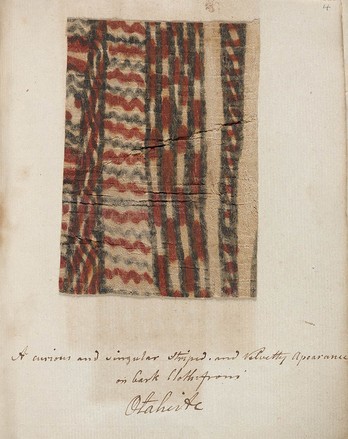The
fabric produced was often thick and cardboard-like, and had to be sewn together
when making skirts or loincloths. Bone or wooden needles were used, and
the thread was made from bark fibre.
‘Conserving
Curiosities’, Pitt Rivers Museum, University of Oxford
Though there are a variety of local names, the
word tapa, originally from Tahiti, is commonly used to refer to bark cloth made
all over the world.
Tapa Cloth, Museum of Natural and
Cultural History, University of Oregon
Many
of the pieces of tapa in Shaw's book are from Hawaii. These samples were
almost certainly brought back from Cook's third voyage.
‘Conserving
Curiosities’, Pitt Rivers Museum, University of Oxford
Hawaiian
barkcloth reached a high level of sophistication, due in part to the climate of
the islands, which was very suitable for the growth of the paper mulberry (Broussonetia
papyrifera) and the breadfruit (Artocarpus incisa), which were the
sources of the bark.
‘Conserving
Curiosities’, Pitt Rivers Museum, University of Oxford
Dyes
and pigments were obtained from a wide range of sources, mainly from plants but
minerals such as red and yellow ochre were also used. Tapa was often
scented, with plants such as a fragrant fern (Polypodium phymatodes),
sandalwood (Santalum spp.) and ginger.
‘Conserving
Curiosities’, Pitt Rivers Museum, University of Oxford
Once
dyed, decoration was applied to the surface of the tapa in many ways.
Many of the Shaw barkcloth samples are decorated with bold geometric designs,
which were common in eighteenth century Hawaiian tapa.
‘Conserving
Curiosities’, Pitt Rivers Museum, University of Oxford
Documenting patterns and
cloth styles from eighteenth century Tahiti, Hawaii and Tonga, this unusual
work introduced Pacific tapa to the western world.



 Back to list
Back to list